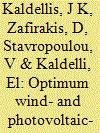|
|
|
Sort Order |
|
|
|
Items / Page
|
|
|
|
|
|
|
| Srl | Item |
| 1 |
ID:
111405


|
|
|
|
|
| Publication |
2012.
|
| Summary/Abstract |
Renewable energy sources (RES) based stand-alone systems employing either wind or solar power and energy storage comprise a reliable energy alternative, on top of conventional diesel-electric generator sets, commonly used by remote consumers. However, such systems usually imply the need for oversizing and considerable energy storage requirements leading to relatively high costs. On the other hand, hybrid configurations that may exploit both wind and solar potential of a given area may considerably reduce energy storage capacity and improve the economic performance of the system. In this context, an integrated techno-economic methodology for the evaluation of hybrid wind-photovoltaic stand-alone power systems is currently developed, aiming at the designation of optimum configurations for a typical remote consumer, using economic performance criteria. For the problem investigation, the developed evaluation model is applied to four representative areas of the Greek territory with different wind potential characteristics in order to obtain optimum configurations on the basis of minimum initial investment, 10-year and 20-year total cost. According to the results obtained, the proposed solution is favorably compared with all other stand-alone energy alternatives, reflecting the ability of hybrid systems to adjust even in areas where the local RES potential is not necessarily of high quality.
|
|
|
|
|
|
|
|
|
|
|
|
|
|
|
|
| 2 |
ID:
104915


|
|
|
|
|
| Publication |
2011.
|
| Summary/Abstract |
In the case of the telecommunication (T/C) services' expansion to rural and remote areas, the market generally responds with the minimum investments required. Considering the existing situation, cost-effective operation of the T/C infrastructure installed in these regions (i.e. remote T/C stations) becomes critical. However, since in most cases grid-connection is not feasible, the up-to-now electrification solution for remote T/C stations is based on the operation of costly, oil consuming and heavy polluting diesel engines. Instead, the use of photovoltaic (PV)-based hybrid power stations is currently examined, using as a case study a representative remote T/C station of the Greek territory. In this context, the present study is concentrated on the detailed cost-benefit analysis of the proposed solution. More precisely, the main part of the analysis is devoted to develop a complete electricity production cost model, accordingly applied for numerous oil consumption and service period scenarios. Note that in all cases examined, zero load rejections is a prerequisite while minimum long-term cost solutions designated are favorably compared with the diesel-only solution. Finally, a sensitivity analysis, demonstrating the impact of the main economic parameters on the energy production cost of optimum sized PV-diesel hybrid power stations, is also provided.
|
|
|
|
|
|
|
|
|
|
|
|
|
|
|
|
| 3 |
ID:
116720


|
|
|
|
|
| Publication |
2012.
|
| Summary/Abstract |
The main aim of the specific research is the comparison of the energy pay-back period of optimum renewable energy sources (RES)-based configurations, meaning wind-battery and photovoltaic-battery stand-alone installations that may ensure the energy autonomy of a typical remote consumer under the condition of minimum life cycle (LC) energy content. In this context, energy autonomy is first ensured on the basis of an appropriate sizing methodology, while accordingly, by developing a calculation algorithm for the estimation of the LC energy content of such energy autonomous systems, minimum LC embodied energy configurations are eventually obtained. On top of that, three representative areas are examined so as to investigate the influence of the local wind and solar potential. According to the results, the sustainable character of both RES-based solutions is designated, especially when comparison with the conventional diesel-engine solution is carried out. On the other hand, the situation is inversed when comparing stand-alone and grid-connected RES systems of the same size, with significant contribution of the battery storage component being reflected.
|
|
|
|
|
|
|
|
|
|
|
|
|
|
|
|
|
|
|
|
|